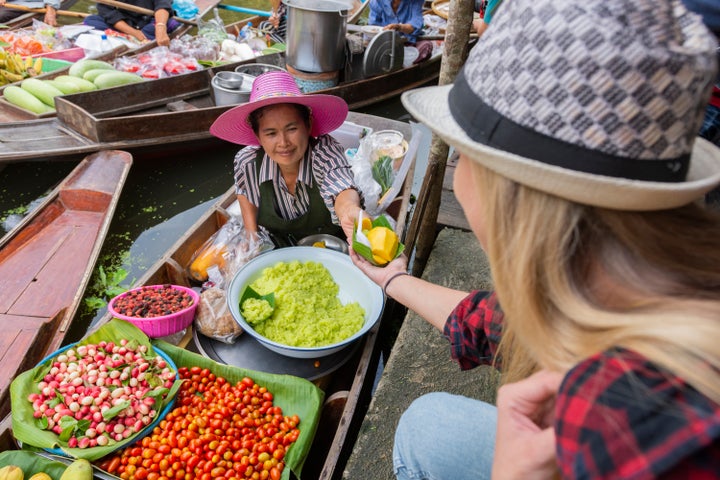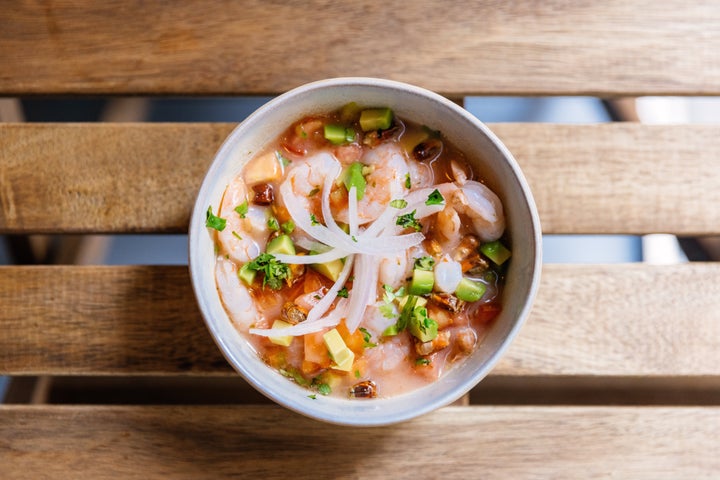
When you’re traveling abroad, you probably have a long list of must-sees and must-dos. Diarrhea, vomiting and stomach cramps most definitely aren’t on that list, but these digestive problems can be all too common.
The Centers for Disease Control and Prevention estimates that 30% to 70% of vacationers get traveler’s diarrhea, depending on where and when they go. The illness can often (but not always) be prevented by paying close attention to what you eat or drink, and by following the “boil it, cook it, peel it or forget it” rule.
“Foodborne infections can strike at any time,” Leah Silberman, a registered dietitian with Medical Offices of Manhattan, told HuffPost. “Traveling exposes you to new food sources, local food handling procedures and different cleanliness standards. This raises your chances of coming into contact with infections or pollutants, against which your body may not have built protection.”
Foods may also be contaminated with unsafe drinking water, or when handwashing isn’t the norm or isn’t done properly, said Mitzi Baum, CEO of the nonprofit Stop Foodborne Illness.
Before traveling, it’s a good idea to check the CDC’s list of destinations, which highlights food or water safety issues, Baum said.
Keep in mind, though, that you can get sick anywhere, including the U.S. About one in six Americans contract foodborne illness each year, which results in 3,000 deaths and 128,000 hospitalizations, according to the CDC.
Travel enhances your risk of getting digestive issues, however. Along with not being acclimated to the foods or encountering different food-handling processes, jet lag and changes in climate can weaken your immune system, Silberman explained.
Next time you travel, follow these tips for protecting yourself from traveler’s diarrhea. Dietitians and food safety experts explain which foods are more likely to put you at risk for foodborne illness.
What Is Traveler’s Sickness?
Traveler’s diarrhea is the most common travel-related illness, and you get it by consuming tainted foods or drinks, according to the CDC.
E. coli bacteria is the main culprit, Baum said, but travelers can also get sick from salmonella, shigella or campylobacter. Viruses, like astrovirus, norovirus and rotavirus, can also be to blame, as well as the parasite giardia.
It often happens in instances of poor food handling, a lack of sanitation or contaminated drinking water, Silberman said.
Diarrhea, abdominal pain, cramping, nausea, vomiting and fever are the most common symptoms of traveler’s diarrhea, according to the Cleveland Clinic. Symptoms of viral or bacterial infections typically show up within six to 24 hours, but parasites can take a few weeks to show signs.
The highest-risk destinations are Asia (except for Japan and South Korea), the Middle East, Africa, Mexico and Central and South America, according to the CDC.
Washing your hands frequently with soap and water, especially after using the bathroom and before eating, can reduce your risk, Baum said.

Foods And Drinks To Avoid When Traveling Abroad
You can actually get foodborne illness from any food or beverage. But some might be riskier than others, depending on where you travel.
Food safety measures, sanitary standards, and culinary habits vary in different parts of the world, Silberman said. Your best bet is to research food safety and health risks for your destination.
But here are some foods and drinks to consider avoiding.
Raw fish and meat
Raw meat and seafood are a “big no-no,” according to Vanessa Rissetto, a registered dietitian and co-founder and CEO of Culina Health. “We can’t source where they came from, how long they’ve been out, and how they’ve been handled.”
Rare steaks, tartare, sushi, ceviche or raw seafood, or inadequately prepared meat, fish or seafood can increase your risk for consuming bacteria, parasites or viruses, Silberman said.
Fresh fruits and vegetables
Fresh fruits and vegetables that seem to have been sitting out for a while could attract germs that might make you sick, Rissetto said. Opt for cooked produce when you can, which will ensure that it reaches temperatures high enough to kill pathogens.
“If you’re going to eat fresh fruits and vegetables, they are safest when washed with potable water and peeled by the person who eats them,” Baum added.
Also, choose fruits and vegetables with thick skins — like bananas, oranges or avocados — that can be peeled, Silberman said. “Peel them yourself to reduce the possibility of eating pathogens.”
Dairy
Pasteurized milk and dairy products from sealed containers are usually safe to consume, according to the CDC. But unpasteurized items, including cheese, yogurt or ice cream, are more likely to contain hazardous germs, like listeria, salmonella or E. coli, Silberman said. It’s also a good idea to avoid dairy that’s been stored at room temperature or left out, such as cream for coffee.
Tap water
Contaminated water is a big cause of traveler’s diarrhea. “Since pathogens aren’t visible to the naked eye, it’s hard to tell if the water is safe to drink,” Baum said.
To learn about the safety of tap water in your destination, visit the CDC’s travelers’ health website, where you can search by country.
Whenever you’re not sure about the safety of water, drink factory-sealed bottled water and remove ice from your drinks, Baum said. You can also boil water for at least a minute.
Be careful not to swallow any water in the shower if you’re visiting a place where the water isn’t safe to drink, and use bottled water to brush your teeth, Rissetto said.
Certain types of street food
Sampling food from street vendors is a fun way to sample local cuisine, but the CDC warns that some may not adhere to the same safety practices — like hand-washing and checking food temperatures — as restaurants. It’s always best to avoid foods and drinks that seem to be sitting around for a while. Items that come straight off a grill, for instance, that are piping hot and cooked are likely safer.
What If You Get Sick While Traveling?
If, despite your best efforts, you do get a case of traveler’s diarrhea, it’s usually not serious. But it can persist for a few days or a week (longer if it’s caused by a parasite), ruining your trip. Silberman offered these tips for taking care of yourself if that happens:
- Stay hydrated. Diarrhea and vomiting can be dehydrating, so drink lots of bottled water or other safe fluids.
- Take an over-the-counter medication. Antidiarrheals, like loperamide (Imodium), or anti-nausea drugs, like dimenhydrinate (Dramamine), help relieve symptoms. Talk to a health care expert first, though, especially if you’re taking other medications.
- See a doctor. If your symptoms aren’t going away, they’re severe, or you also have a fever, bloody stool, or dehydration, seek medical attention. Call your doctor when you get home if you still have symptoms or if you have an underlying medical condition.
No one wants to get sick while traveling, of course. But remember that foodborne illness can happen anywhere, Rissetto noted.
“If we go on vacation overly worried about every single thing we’re eating, we might not be able to truly enjoy the experience,” she said. “You can determine what’s right for you in the moment.”
